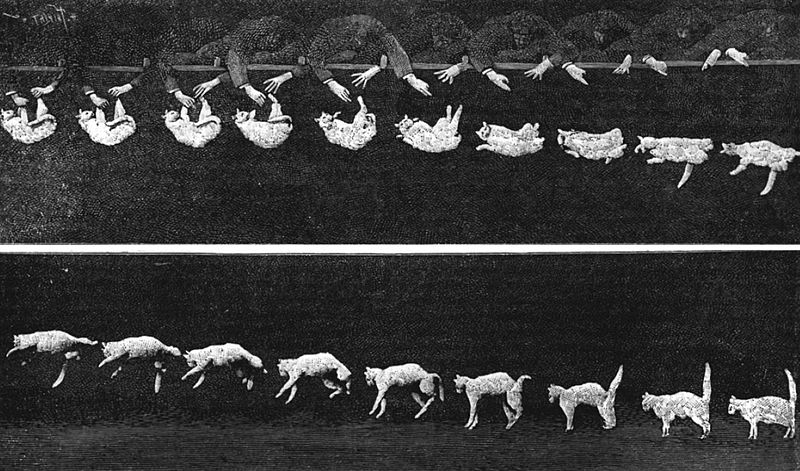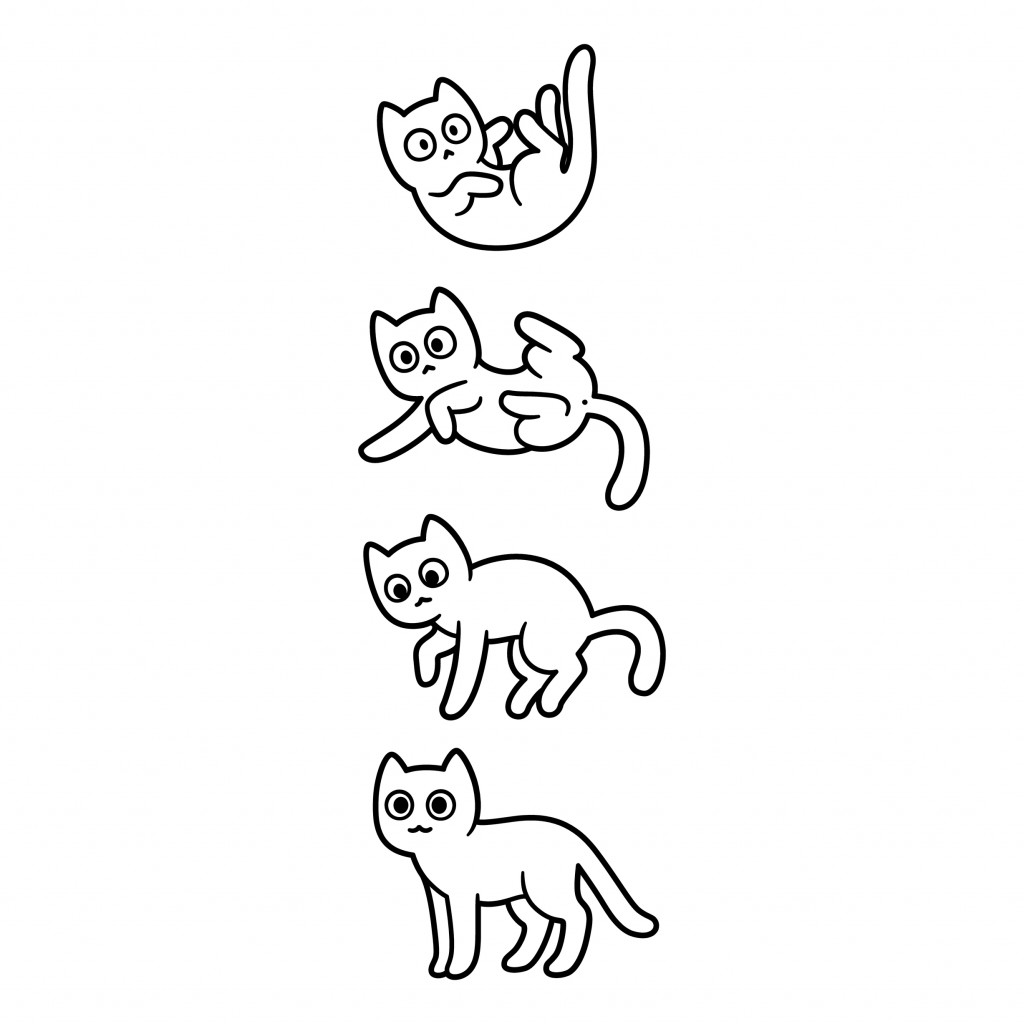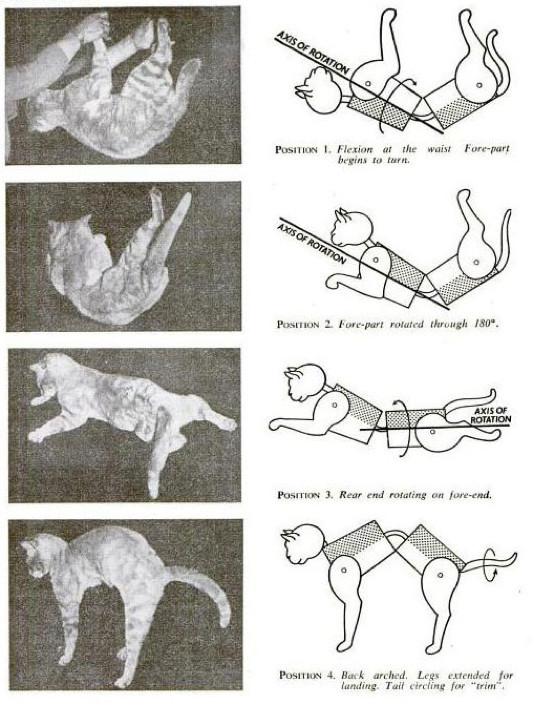Table of Contents (click to expand)
Cat’s perform what is called a “righting reflex”. The cat cleverly uses the forces of physics to rotate its body and avoid any injuries from a free-fall. How does the cat manage to do this, and can you manage to do it too?
Cats are incredibly agile and flexible. They can squeeze into tight places and leap to seemingly impossible heights. Yet, they emerge unhurt from such risky endeavors, always landing on their four paws.
But how do they do this? And are cats the only animal with such a death-defying superpower?
Marey’s Falling Cat Experiment
Scientists of the 19th century were perplexed by the ability of some animals to inverse their body orientation while falling, such as the infamous phenomenon of cats.
Étienne Jules Marey was one such scientist. In 1894, Marey tried to understand the dynamics of a falling cat by dropping a cat upside down and clicking a series of images using chronophotography. Chronophotography is the method of capturing a series of phases of movement.
With the help of this photography technique, he captured the cat’s successive phases of falling motion and published them in the Nature journal.

Photographs of a Falling Cat by Étienne Jules Marey, 1894 (Photo Credit: Etienne-Jules Marey/Wikimedia Commons)
Previously, some believed that cats would push against the hands of the person dropping it to flip its body, but Marey’s photos show otherwise. The cat shows no rotation at the beginning of the fall, but instead flips mid-free fall. This means that the cat acquires angular momentum while in free-fall…
But that defies the law of physics!
According to Newton’s Law of Motion, no object can change its motion unless an external force acts upon it, so how are cats able to defy physics?
Also Read: Is Schrödinger’s Cat Dead Or Alive?
How Do Cats Rotate Their Body While Falling?
At the beginning of a fall, the cat is upside down with its four paws pointing toward the sky, while its back faces the ground. The only force acting on the cat is the gravitational force, which is in the vertical direction.
To turn its body around, the cat requires an external force acting in another direction, so that it can flip its body and point its paws towards the ground. Since the cat is floating in the air during its fall, there is no such external force that can help the cat flip. Instead, the cat helps itself by twisting its body muscles to rotate.
Also Read: Should You Relax Your Body Completely Before Impact While Falling Down?
Righting Reflex
To protect the body and avoid any injuries from the free-fall, some animals turn themselves around mid-air in order to land safely on their feet. The ability of animals to reorient their body while falling is known as the righting reflex. This aerial righting reflex has been recorded in many mammals, including cats, guinea pigs, rabbits, rats and primates.
Cats and geckos reorient their body via the conservation of angular momentum.
Marey’s images show that the cat arches its back as it begins to fall. This effectively breaks the cat’s body into two different parts. To understand the falling cat problem, we need to look at the upper and hind parts of the cat as two rigid cylinders with different rotational axes.

The cat starts to rotate its head towards the camera with its hind legs extended, while simultaneously pulling its front legs in. You might have seen figure skaters pull their arms in while spinning. By pulling their arms in, they increase their angular velocity, which helps them spin faster. Cats apply the same principle while falling.
As the front part of the cat’s body rotates around 180° about its waist, the hind part of its body rotates in the opposite direction by about -5° to prevent the total angular momentum from changing. Thus, the resultant angular momentum is zero, since the opposite spin of the two separate parts of the cat cancels each other out.

As its head and front paws face the ground, the cat extends its front legs while contracting its hind legs. This allows the hind legs to catch up with the front legs. Thus, by reversing the process, the cat can rotate its hind part and align it with the front.
With all four paws of the cat facing the ground, the cat can make a safe and cushy landing.
Sadly, we humans are not blessed with this amazing superpower. That being said, humans do exhibit a form of the righting reflex called the postural righting reflex. These include visual righting reflexes, labyrinthine righting reflexes and neck righting reflexes, to name just a few. These reflexes may not save our lives if we take a fall, but they certainly help us maintain proper body orientation and posture.
Conclusion
A cat in New York once fell from the 32nd floor onto concrete, only to end up with a chipped tooth and a collapsed lung. The cat was ready to return home after 48 hours. The righting reflex has turned out to be a literal life-saving boon for cats across the world.
However, the righting reflex in cats doesn’t make them immune to the grave dangers of falling from significant heights. According to a study, 96.5% of cats survived high-rise falls. However, even though they lived through the fall, many cats suffered from various bone fractures and permanent changes to physical health. This shows that although they possess the power of a quick righting response, cats don’t always emerge completely unharmed after taking a fall!
How well do you understand the article above!

References (click to expand)
- Information R. B. (1960). New Scientist:. Reed Business Information
- Why Do Cats Always Land on Their Feet? - Phil Kesten. Santa Clara University
- Yang, J. (2021). The Development of Explanation of Falling Cat Problem and Applications of Falling Cat Phenomenon. Advances in Social Science, Education and Humanities Research. Atlantis Press.
- Jusufi, A., Zeng, Y., Full, R. J., & Dudley, R. (2011, September 19). Aerial Righting Reflexes in Flightless Animals. Integrative and Comparative Biology. Oxford University Press (OUP).
